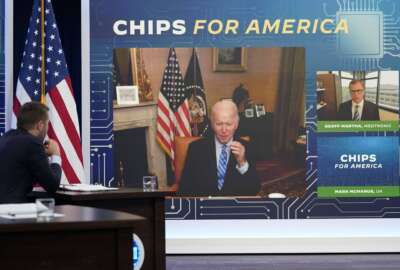The CHIPS Act is pushing Silicon Valley inland
The money from the CHIPS Act is part of larger outlays under its program, known as the Microelectronic Commons overseen by the Naval Surface Warfare Center.
Some $31 million from the CHIPS Act just went to a group called the Midwest Microelectronics Consortium. The money is part of larger outlays under a CHIPS Act program, known as the Microelectronic Commons overseen by the Naval Surface Warfare Center. Matt Casto, the chief technology officer of the Midwest Microelectronics Consortium, joined the Federal Drive with Tom Temin to untangle what’s going on.
Interview transcript:
Tom Temin: What is the Midwest Microelectronics Consortium? Let’s start there.
Matt Casto: Right. Yeah. So the Midwest Micro Electronics Consortium, or MMEC, we say is basically an innovation hub. It was established under the CHIPS and Science Act as part of the Microelectronics Commons program. And we’re about 400 members strong, really focused on lowering the barriers to innovation to accelerate microelectronics technology.
Tom Temin: All right. And the Commons program then under the CHIPS Act, so you’re part of a larger program that’s overseen by the Naval Surface Warfare Center?
Matt Casto: Yeah. So the Microelectronics Commons program consists of eight hubs around the nation, kind of all focused on different technology areas, access to different infrastructure, critical to semiconductor and microelectronics development. And the program was initiated out of the CHIPS and Science Act. And there’s actually a special part of the allocation that was focused on the Department of Defense. And so really trying to accelerate technologies that are important to our warfighters, making sure that we have the best technology on the battlefield, as well as trying to leverage kind of economies of scale and where dual-use commercial technology can be leveraged. And so as part of that, that money was initiated through the CHIPS and Science Act. But under the kind of execution purview of the Office of the Secretary of Defense and Research and Engineering and the Naval Surface Warfare Center, Crane is the technical execution agent that’s responsible for executing the contracting, providing technical oversight. Those types of things.
Tom Temin: And the consortium itself, the Midwest, the MMEC. What types of companies are members of it?
Matt Casto: And so we’re the largest market electronics commons hub. So over 400 members. And those range from academic institutions. So Tier 1 universities, community colleges to startups and small businesses all the way through large businesses and corporations that span across the entire supply chain for microelectronics technology.
Tom Temin: And modern microelectronics, especially what the military is looking for and if you get into this AI chip business and so forth, is extremely capital intensive. Plus, there is an amazingly complex and sophisticated design cycle that goes into designing these chips. I mean, billions to produce a new chip. What can something like this consortium add to this or and what will you get out of this money?
Matt Casto: Yeah. So we’re focused on really going back to some of the foundational pieces of innovation, the things that helped us be the country that invented advanced microelectronics. So we’re really going back to making sure that whether that’s a startup or small business has access to some of the foundational infrastructure. Like you said, it’s really capital intensive. So individual companies largely, can’t do this alone. So one of the things that we’re working on is providing really lowering barriers and providing pathways to get access to critical equipment, access to design tools. So we’re actually in one instance, we’re working with six of the hubs have come together to drive requirements and work with the electronic design automation tool companies. So you think of those as the CAD tool companies of the microelectronics world. And we’re actually working together to aggregate requirements to drive efficiencies, to lower costs, to increase access and significantly reduce the amount of time it takes to get some of the best companies hands on the technology so they have access to it.
Tom Temin: We’re speaking with Matt Casto. He’s chief technology officer of the Midwest Microelectronics Consortium. So is the theory behind this, then, that there might be some really bright students at a particular university if only they could get their hands on expensive tools say they could design the next chip for underwater missile guidance? I’m making that up. But is that the general idea here?
Matt Casto: I’d say that’s one aspect. Generally, academic institutions, especially the large ones, will have access to educational licenses or things that they can do some training on. But broadly, the biggest barriers to some of the innovation is in startups and small businesses. Is that the cost of tools becomes prohibitive. And so providing them access, though, they may have to use say like a lower quality or less proficient tool basis to do development. Typically, we want to make sure that they have the best technology. We want to work on each company with their expertise to be focused on what they’re the best at in the whole ecosystem. As I mentioned, we organized our consortium around those tenets of innovation. So we have foundation members, which are providing access to the tools, infrastructure. Those can be semiconductor manufacturing tools or electronic design automation tools. We kind of group that into digital and physical infrastructure. And then we have Keystone members, which are those kind of large defense contractors that are responsible for building systems, or they may be companies that are putting products out in the market. And then we have our pillar members, which are those kind of the think of those as the engineering R&D team within any company. But we really expanded that to make any startup small business that has the best ideas, including academia, filling that role of being the engineering R&D team. We want them to focus on doing the technology development, not worrying about how to get access to infrastructure tools and capabilities, and then also early in the process, making sure that they understand the requirements. So when they develop technology, it has the best chance to transition.
Tom Temin: And maybe tell us your vision for how one side reaches the other. In other words, you can envision someone being able to design a complex chip with the right tools and the right know-how, or a group of people being able to do it a team. But then that’s the design. And now the model in the United States is let’s ship the design to Taiwan or somewhere, and they’ll fabricate it because the fabrication, it’s like designing a great car with CAD and so forth, but getting it built. All of a sudden, you’ve got $1 billion capital just to make a frame line, let alone everything else that goes into a car. It’s like a valley of death here. How do you envision that being bridged?
Matt Casto: Yeah, that’s exactly right. It’s the traditional. It’s called the Valley of Death. Is that maturation both on the technology and manufacturing readiness levels. And so what we’re doing, as you know, part of the activities is we’re not only lowering barriers to the early stages, right, to do the design, but all the way through the entire microelectronics life cycle. So one of the things that part of the investment that’s being made in MMEC is we’re establishing what we call ramp lines. And so these are prototyping manufacturing capabilities, which will take early demonstrations that have occurred in the labs, whether that be in academia or small business or startups. And we’re accelerating that to a maturity level where a prototype is developed that buys down the manufacturing risk. So it takes that early tech risk off the table. Typically, right, hardware companies become extremely risky to invest in both from a time component as well as a dollar component. Right. It’s a much faster, easier and with a much quicker return on investment most of the time to invest in something like software development. And so our focus has been to lower those barriers across the hardware prototyping cycle and identify technologies early on in the process, even before they reach some of the manufacturing capabilities and some of the projects that we were just awarded. We’re working to develop prototypes on Intel’s latest most advanced process technology and demonstrating those in relevant DoD environments. So when that manufacturing process, technology comes online, we’ll already have demonstrated capability in that technology that can readily go to production.
Tom Temin: Right. So that gives a place like Intel a better chance at having good yields from the first few wafers rather than all of that work that goes into the learning curve, as they call it.
Matt Casto: Actually more so on the IP. So when advanced chips are developed, they’re constructed of many different IP blocks and intellectual property. The intellectual property terminology in the semiconductor world is a little different than the general intellectual property terminology. So what we’re doing as part of our initial projects under the Commons program, they’re actually developing those core intellectual property blocks, integrating those into differentiating architectures, things that right now are not out in the commercial market or not available to our warfighters. And we’re developing those and aggregating those and demonstrating their viability and demonstrating their performance so that intellectual property ecosystem as well as the representative capabilities are demonstrated. So really accelerating and crossing that valley of death. So a program office, say the DoD where they’re developing a weapon system or a commercial company developing a new product, doesn’t have to take on all of the risk throughout the development cycle.
Tom Temin: And by the way, what do you bring to this? What’s your background here?
Matt Casto: So my background I spent nearly 20 years as a civil service in the Department of Defense, working all things semiconductors and microelectronics. I got the great opportunity early on in my career actually as an internship working in the Air Force research labs. So I’ve got some great mentorship and access to some of that great infrastructure we’re talking about that isn’t broadly available. And so early on in my career, got to do a lot of bench-level research and then took that to the more strategic level and helped establish the Department of Defense Trusted and Assured Microelectronics Program. And recognizing that there was a need and over time, the DoD had been focused on the trusted foundry ecosystem and the dynamics and the market influences and the economics around that have continued to change very rapidly with the change of the semiconductor industry. And so I helped set that up and got the opportunity to spend a few years at the Pentagon running that program. And then I actually took some of that time and went out to the commercial industry and actually went to develop a secure access IoT products in the middle of the supply chain crisis. So all those things that we learned from developing the visibility into the supply chain on the DoD and seeing how commercial products were affected during the pandemic when every industry had challenges with getting you couldn’t buy a car, washing machine, refrigerator. And so I got a chance to really put a lot of that stuff into practice in terms of the commercial marketplace. And then when the CHIPS Act or the Commons program, it was really a great opportunity to bring all that expertise to I think what’s the most critical problems that we have to solve, which is ensuring that we have the microelectronics we need for our systems that we have that domestic supply chain so we aren’t subjected to a lot of the whether that’s geopolitical influences or supply chain disruptions.
Copyright © 2025 Federal News Network. All rights reserved. This website is not intended for users located within the European Economic Area.
Tom Temin is host of the Federal Drive and has been providing insight on federal technology and management issues for more than 30 years.
Follow @tteminWFED






